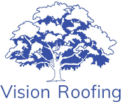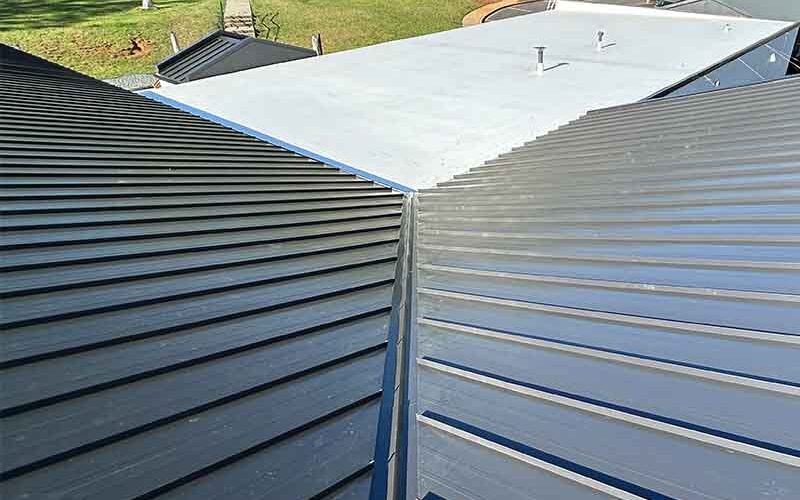Commercial roof leaks can severely impact your business, potentially leading to costly commercial roof replacement in Charlotte, NC if left untreated. Understanding how to prevent leaks from damaging your business is crucial for protecting your inventory, equipment, and daily operations. This comprehensive guide helps property owners recognize the signs of a leaky roof and addresses the most common causes of commercial roofing problems. Whether you’re dealing with minor water damage or considering a full roof assessment, knowing these warning signs and causes can help you take action before small issues become major expenses.
Jump Ahead
- Signs of a Commercial Roof Leak
- Common Causes of Commercial Roof Leak
- Professional Roof Repair Solutions
Signs of a Commercial Roof Leak
Early detection of commercial roof problems can save thousands in repairs and prevent extensive structural damage. Here are the key warning signs that indicate you may have a roof leak in your commercial building:
Visible Water Damage
The most obvious sign of a leaking commercial roof is water actively entering your building. You may notice water puddles forming on floors or water trickling down walls during or after rainfall. Even small drips can indicate a significant roofing issue that needs immediate attention.
Stained Ceilings & Walls
Prolonged water exposure leaves telltale marks on your building’s interior surfaces. Water stains typically appear as yellowish or brownish discoloration on ceiling tiles, and may create streaking patterns down walls. These stains often grow larger over time as the leak continues.
Mold Growth
Persistent moisture creates the perfect environment for mold development. Look for black, green, or dark-colored spots, especially in corners and along ceiling edges. Mold growth not only indicates a roof leak but can also pose serious health risks to building occupants and require professional remediation.
Musty Odors
Even before mold becomes visible, you may notice a distinct musty smell in your commercial space. These stale, earthy odors typically persist despite ventilation or air fresheners. If you detect these smells, particularly in upper floors or after rain, it’s important to have your roof inspected for leaks.
Common Causes of Commercial Roof Leaks
If you notice signs of a commercial roof leak in your Charlotte business, an immediate professional assessment from a roofing contractor is crucial. Understanding these common causes can help you identify potential issues before they lead to extensive damage.
Poor Drainage
Since most commercial buildings have flat roofs, contractors install rather extensive drainage systems. These systems consist of interior drains, gutters, downspouts, and scuppers. When one of these components fails – or is clogged by leaf debris – water can begin “ponding” on your roof.
Pooled water creates two significant risks:
- Water can penetrate the roof membrane, leading to interior damage and mold growth
- The additional weight from standing water can stress your building’s structure, potentially causing ceiling collapse in severe cases
Open Penetrations
Your commercial roof contains numerous penetration points for essential systems, including HVAC units, vents, drains, pipes, and gas lines. These areas require proper sealing to maintain your roof’s waterproof integrity. When seals deteriorate or weren’t properly installed, they create vulnerable points for water intrusion.
Fortunately, many penetration-related leaks can be addressed with professional caulking or sealant application if caught early.
Damaged Roof Membrane
The membrane is your roof’s primary waterproof barrier, typically constructed from tar and gravel or polyurethane materials. While natural aging affects all roof membranes, damage can accelerate from:
- Severe weather exposure
- Regular foot traffic
- Poor initial installation
- Lack of maintenance
Small membrane damage might only require patching, but extensive deterioration often necessitates a complete membrane replacement to ensure proper protection.
Improperly Installed Roof Flashings
Roof flashing, a thin metal material installed at roof joints and around features like chimneys, plays a critical role in directing water away from vulnerable areas. When flashing is incorrectly installed or degraded by weather exposure, it can allow water to penetrate beneath your roofing material. This seepage often leads to damage in:
- Underlying insulation
- Electrical systems
- Structural supports
Poor Roof Ventilation
Commercial buildings rely on roof ventilation systems to manage heat accumulation in upper spaces. These vents serve dual purposes: releasing trapped heat while preventing cold air infiltration. However, ventilation problems can create moisture issues when:
- Warm, humid air becomes trapped
- Condensation forms inside the building
- Air flow patterns are disrupted
Proper ventilation maintenance helps prevent these moisture-related problems from developing into serious leaks.
Faulty Skylights
While skylights provide natural lighting that enhances commercial spaces, they can become problematic leak sources. Issues typically stem from:
- Damaged flashing around skylight frames
- Cracked or deteriorated skylight materials
- Poor initial installation
Some skylight issues may require coordination between roofing professionals and general contractors to ensure proper repair or replacement.
Tree Debris
Organic debris accumulation creates significant risks for commercial roofs, particularly after storms. When leaves, branches, and other vegetation collect on your roof, they can:
- Block water drainage paths
- Create areas of standing water
- Trap moisture against roofing materials
Regular roof maintenance and debris removal are essential for preventing these organic material-related leaks and storm damage.
Snow & Ice Buildup
In colder weather, ice dam formation at roof edges can prevent proper drainage of melting snow. These ice dams:
- Block normal water runoff
- Force water to back up under roofing materials
- Create additional weight stress on the roof structure
While immediate solutions like roof rakes can help, long-term prevention often requires improved ceiling insulation to maintain consistent roof surface temperatures.
Wildlife Infestation
Even small animals can create significant roofing problems. Common culprits include:
- Rodents (mice and rats)
- Raccoons
- Possums
These animals may damage roofing materials to create entry points, which grow larger with continued use. Addressing wildlife issues typically requires both:
- Pest control services
- Professional roof repair
Roof Age
Most commercial roofs have an expected lifespan of 15-20 years, though this varies based on:
- Roofing material type
- Installation quality
- Maintenance frequency
- Local weather conditions
Regular professional inspections become increasingly important as your roof ages, helping determine whether repairs or complete replacement is the most cost-effective solution.
Trust Vision Roofing for Your Commercial Roof Needs in Charlotte
As a trusted Charlotte roofing company, Vision Roofing specializes in comprehensive commercial roofing services, from routine maintenance to emergency leak repair. Our experienced team can quickly identify the cause of your commercial roof leak and develop an effective solution to protect your business investment.
Contact Vision Roofing online or call 704-312-8558 to schedule a free roof inspection and learn more about our Charlotte roofing services.


